Welcome to DU!
The truly grassroots left-of-center political community where regular people, not algorithms, drive the discussions and set the standards.
Join the community:
Create a free account
Support DU (and get rid of ads!):
Become a Star Member
Latest Breaking News
Editorials & Other Articles
General Discussion
The DU Lounge
All Forums
Issue Forums
Culture Forums
Alliance Forums
Region Forums
Support Forums
Help & Search
Environment & Energy
Related: About this forumThe Biological Consequences of Benny Sovacool's Call for Deep Sea Mining to Go "Green."
The paper I’ll discuss in this post is this one: Impacts of Mining Polymetallic Nodules on Surface Seawater and Marine Picophytoplankton Shuangshuang Lin, Jinli Qiu, Xiaohu Li, Yangsheng Zhong, Kailun Huang, Lei Wang, and Xuguang Huang
Environmental Science & Technology 2025 59 (31), 16591-16602
The paper does not in any place, despite the title of this post, refer to the antinuke Benny Sovacool; the reference is totally mine based on my strong reaction to a paper of which he is the author, this one:
Sustainable minerals and metals for a low-carbon future
Subtitle:
Policy coordination is needed for global supply chains.
Benjamin K. Sovacool and Saleem H. Ali and Morgan Bazilian and Ben Radley and Benoit Nemery and Julia Okatz and Dustin Mulvaney, Sustainable minerals and metals for a low-carbon future, Science, 367, 6473, 30-33, 2020,
I am pleased to say this paper sticks in my craw.
Quoth Benny et al.:
Climate change mitigation will create new natural resource and supply chain opportunities and dilemmas, because substantial amounts of raw materials will be required to build new low-carbon energy devices and infrastructure (1). However, despite attempts at improved governance and better corporate management, procurement of many mineral and metal resources occurs in areas generally acknowledged for mismanagement, remains environmentally capricious, and, in some cases, is a source of conflict at the sites of resource extraction (2). These extractive and smelting industries have thus left a legacy in many parts of the world of environmental degradation, adverse impacts to public health, marginalized communities and workers, and biodiversity damage. We identify key sustainability challenges with practices used in industries that will supply the metals and minerals—including cobalt, copper, lithium, cadmium, and rare earth elements (REEs)—needed for technologies such as solar photovoltaics, batteries, electric vehicle (EV) motors, wind turbines, fuel cells, and nuclear reactors. We then propose four holistic recommendations to make mining and metal processing more sustainable and just and to make the mining and extractive industries more efficient and resilient.
Between 2015 and 2050, the global EV stock needs to jump from 1.2 million light-duty passenger cars to 965 million passenger cars, battery storage capacity needs to climb from 0.5 gigawatt-hour (GWh) to 12,380 GWh, and the amount of installed solar photovoltaic capacity must rise from 223 GW to more than 7100 GW (3). The materials and metals demanded by a low-carbon economy will be immense (4). One recent assessment concluded that expected demand for 14 metals—such as copper, cobalt, nickel, and lithium—central to the manufacturing of renewable energy, EV, fuel cell, and storage technologies will grow substantially in the next few decades (5). Another study projected increases in demand for materials between 2015 and 2060 of 87,000% for EV batteries, 1000% for wind power, and 3000% for solar cells and photovoltaics (6). Although they are only projections and subject to uncertainty, the World Bank put it concisely that “the clean energy transition will be significantly mineral intensive” (7) (see the figure).
Many of the minerals and metals needed for low-carbon technologies are considered “critical raw materials” or “technologically critical elements,” terms meant to capture the fact that they are not only of strategic or economic importance but also at higher risk of supply shortage or price volatility (8). But their mining can produce grave social risks. A majority of the world's cobalt, used in the most common battery chemistries for EVs and stationary electricity storage, is mined in the Democratic Republic of Congo (DRC) (see the map), a country struggling to recover from years of armed conflict. There, women and sometimes children often work in or around mines for less pay or status than their male and adult counterparts, without basic safety equipment (see the photo). Owing to a lack of preventative strategies and measures such as drilling with water and proper exhaust ventilation, many cobalt miners have extremely high levels of toxic metals in their body and are at risk of developing respiratory illness, heart disease, or cancer...
Between 2015 and 2050, the global EV stock needs to jump from 1.2 million light-duty passenger cars to 965 million passenger cars, battery storage capacity needs to climb from 0.5 gigawatt-hour (GWh) to 12,380 GWh, and the amount of installed solar photovoltaic capacity must rise from 223 GW to more than 7100 GW (3). The materials and metals demanded by a low-carbon economy will be immense (4). One recent assessment concluded that expected demand for 14 metals—such as copper, cobalt, nickel, and lithium—central to the manufacturing of renewable energy, EV, fuel cell, and storage technologies will grow substantially in the next few decades (5). Another study projected increases in demand for materials between 2015 and 2060 of 87,000% for EV batteries, 1000% for wind power, and 3000% for solar cells and photovoltaics (6). Although they are only projections and subject to uncertainty, the World Bank put it concisely that “the clean energy transition will be significantly mineral intensive” (7) (see the figure).
Many of the minerals and metals needed for low-carbon technologies are considered “critical raw materials” or “technologically critical elements,” terms meant to capture the fact that they are not only of strategic or economic importance but also at higher risk of supply shortage or price volatility (8). But their mining can produce grave social risks. A majority of the world's cobalt, used in the most common battery chemistries for EVs and stationary electricity storage, is mined in the Democratic Republic of Congo (DRC) (see the map), a country struggling to recover from years of armed conflict. There, women and sometimes children often work in or around mines for less pay or status than their male and adult counterparts, without basic safety equipment (see the photo). Owing to a lack of preventative strategies and measures such as drilling with water and proper exhaust ventilation, many cobalt miners have extremely high levels of toxic metals in their body and are at risk of developing respiratory illness, heart disease, or cancer...
Ah, Benny cares about “women (and sometimes) children.” Who knew? I wish I could say I’m impressed, but frankly, I’m out of fucks to give where Benny is concerned. I note that bringing the female and child cobalt slaves up to the status of their male counterparts may not amount to much. A male slave is still a slave.
I’ll return to Benny later in this post. From the paper cited at the outset:
The depletion of land-based metal resources and declining ore grades have intensified interest in marine minerals, particularly polymetallic nodules (PMNs), cobalt-rich ferromanganese crusts (CFCs), and polymetallic sulfides (PMSs). (1) PMNs are composed of solidified iron and manganese hydroxides, forming through hydrogenetic, diagenetic, or mixed processes, and are primarily found on the seafloor at depths between 4000 and 6500 m. (2) These nodules contain various metals, including nickel (Ni), cobalt (Co), copper (Cu), and rare earth elements, which are increasingly in demand due to the growth of industries such as electric vehicle manufacturing. (3,4) For example, Ni and Co are essential metals in battery manufacturing; despite only constituting 4% and less than 1% of the mass of PMNs, they hold economic values of 50% and 13%, respectively. (5) Notably, the reserves of Ni and Co in the seabed at the Clarion-Clipperton zone (CCZ) in the Pacific Ocean surpass total terrestrial reserves. (3) Given the technical challenges of deep-sea mining, PMNs are more accessible than CFCs and PMSs because they are only partially buried in sediment, making them easier to extract and more commercially viable. (6)
Despite potential economic benefits, deep-sea mining poses significant environmental risks, particularly to marine ecosystems. (7) While much attention has been focused on the effects of mining on benthic habitats and sediment plumes, (8) the consequences of PMNs’ discharge into surface waters remain underexplored. Mining processes may release tailing water and PMNs particles into surface seawater, as occurred during test mining by The Metals Company in 2022, where sediment and PMNs particles leaked, contaminating surface waters (https://metals.co/cyclone-separator-overflow/). (9) Moreover, valuable ores extracted from deep-sea mining areas like the CCZ must be transported back to land, increasing the risk of metal spills during onboard initial handling and processing. (10,11)
The CCZ is home to key picophytoplankton species, including Synechococcus, Prochlorococcus, and picoeukaryotes, which are crucial to carbon cycling and marine productivity. (12) Prochlorococcus and Synechococcus, as the most significant genera of marine picocyanobacteria, (13) play crucial roles in the global carbon cycle, contributing 20%–58% of the total phytoplankton carbon biomass in oligotrophic open oceans. (14,15) Although picoeukaryotes constitute a minor fraction of the picoplankton cell numbers, they are essential primary producers in oligotrophic regions, where they can contribute up to 80% of the autotrophic biomass. (16) Due to their larger cell size, faster growth rates, and vulnerability to predation, picoeukaryotes play a crucial role in energy flow within these ecosystems. (16,17)
The release of metals from PMNs particles into the water column can have complex impacts on marine phytoplankton. At higher concentrations, heavy metals such as Cu, zinc (Zn), and iron (Fe), which are present in PMNs, can become toxic to key oligotrophic species like Synechococcus and Prochlorococcus, inhibiting their growth and disrupting marine ecosystems. (18,19) Additionally, the accumulation of these metals through vertical and horizontal migration poses potential risks to higher trophic levels, as they can bioaccumulate and disrupt food chains. (20)
Despite potential economic benefits, deep-sea mining poses significant environmental risks, particularly to marine ecosystems. (7) While much attention has been focused on the effects of mining on benthic habitats and sediment plumes, (8) the consequences of PMNs’ discharge into surface waters remain underexplored. Mining processes may release tailing water and PMNs particles into surface seawater, as occurred during test mining by The Metals Company in 2022, where sediment and PMNs particles leaked, contaminating surface waters (https://metals.co/cyclone-separator-overflow/). (9) Moreover, valuable ores extracted from deep-sea mining areas like the CCZ must be transported back to land, increasing the risk of metal spills during onboard initial handling and processing. (10,11)
The CCZ is home to key picophytoplankton species, including Synechococcus, Prochlorococcus, and picoeukaryotes, which are crucial to carbon cycling and marine productivity. (12) Prochlorococcus and Synechococcus, as the most significant genera of marine picocyanobacteria, (13) play crucial roles in the global carbon cycle, contributing 20%–58% of the total phytoplankton carbon biomass in oligotrophic open oceans. (14,15) Although picoeukaryotes constitute a minor fraction of the picoplankton cell numbers, they are essential primary producers in oligotrophic regions, where they can contribute up to 80% of the autotrophic biomass. (16) Due to their larger cell size, faster growth rates, and vulnerability to predation, picoeukaryotes play a crucial role in energy flow within these ecosystems. (16,17)
The release of metals from PMNs particles into the water column can have complex impacts on marine phytoplankton. At higher concentrations, heavy metals such as Cu, zinc (Zn), and iron (Fe), which are present in PMNs, can become toxic to key oligotrophic species like Synechococcus and Prochlorococcus, inhibiting their growth and disrupting marine ecosystems. (18,19) Additionally, the accumulation of these metals through vertical and horizontal migration poses potential risks to higher trophic levels, as they can bioaccumulate and disrupt food chains. (20)
The “CCZ,” the Clarion-Clipperton zone, is located SE of Hawaii in international waters. The authors of this paper, now that the United States has deliberately and bizarrely abrogated its scientific strength to benefit an orange pedophile of low intellectual and moral standing, are Chinese, since China, although a functional dictatorship has not abrogated its scientific strength. Rather China is doing the opposite, supporting and funding it’s science and scientists. Guess which country will dominate the future of humanity.
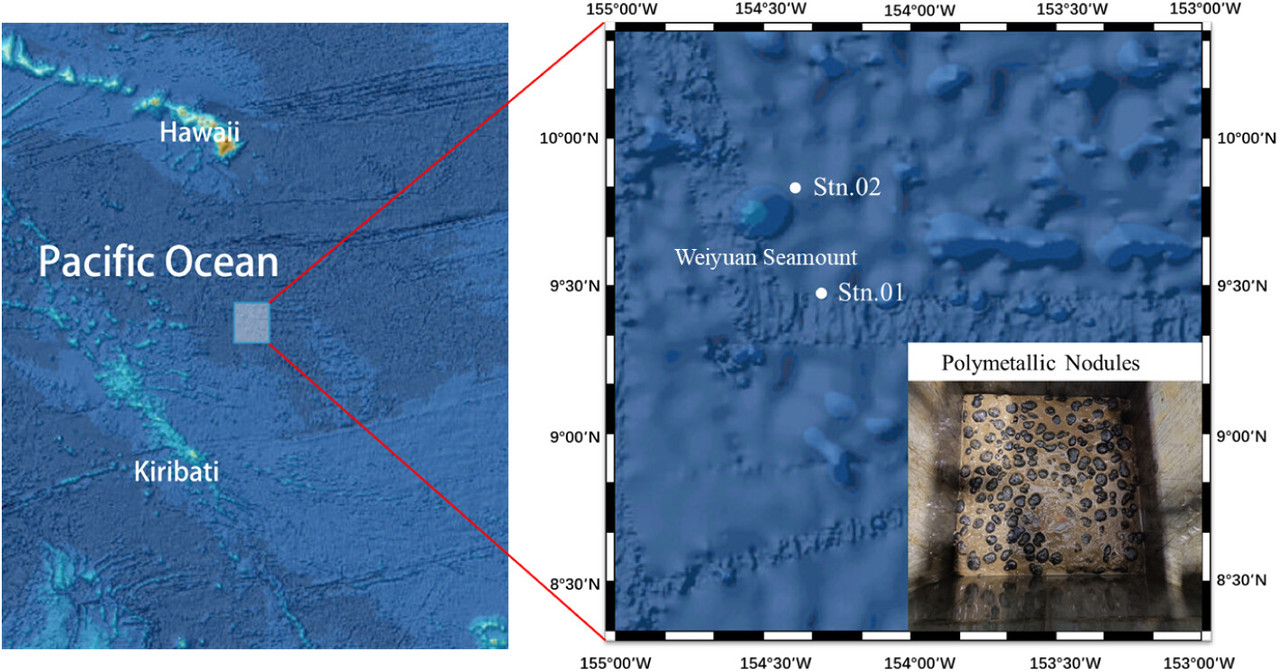
The caption:
Figure 1. Location of the PMNs’ collection and experiment stations.
It is interesting – and frankly – frightening to think about who, as in “what nation?” will develop these putative deep sea mines, and whether military action or even war will be involved with deciding the issue, but don’t worry. Be happy. Benny, a world class hand waver if ever there was one, offers some hopeful handwaving on that issue.
In any case, the authors took a ship out to the CCZ, and over a period of 11 days, collected water samples, filtered them through a 0.22 micrometer filter to remove particulates and organisms, and then sampled the PMN (polymetallic nodules) using a box corer. The seawater was spiked with particles of the ores of different sizes by passing them through a mesh. Then the samples were spiked with the ore particles. Salinity was adjusted over a range, beginning with the "standard" salinity, 35, followed by dilution with distilled water for lower salinity samples. The samples were then agitated in the presence of the selected PMN mesh size, and aliquots removed under a variety of lighting conditions, including darkness, at 5 minutes, 5 hours, 12 hours, 24, hours, 3 days and 7 days.
Work was conducted at two different stations in the area.
To evaluate the effect on organisms, samples were spiked with known concentrations of the species of interest.
Metal concentrations were measured by ICP/MS. The metals evaluated were Fe, Mn, Ni, Cu, Co, Cr, Cd, and Pb, that is iron, manganese, nickel, copper, chromium, cadmium and lead.
Some graphics from the paper:
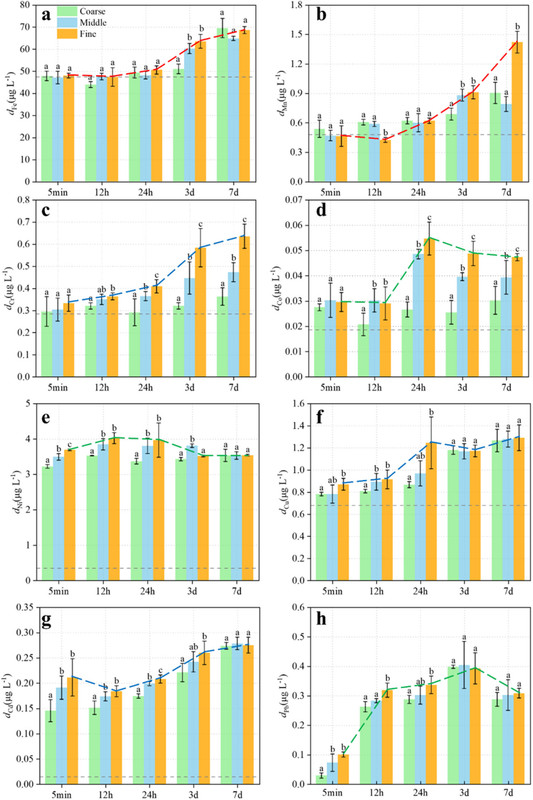
The caption:
Figure 2. The concentrations of dissolved metal in seawater (the dashed line represents the background value). Different letters meant there was significant difference among groups (p < 0.05).
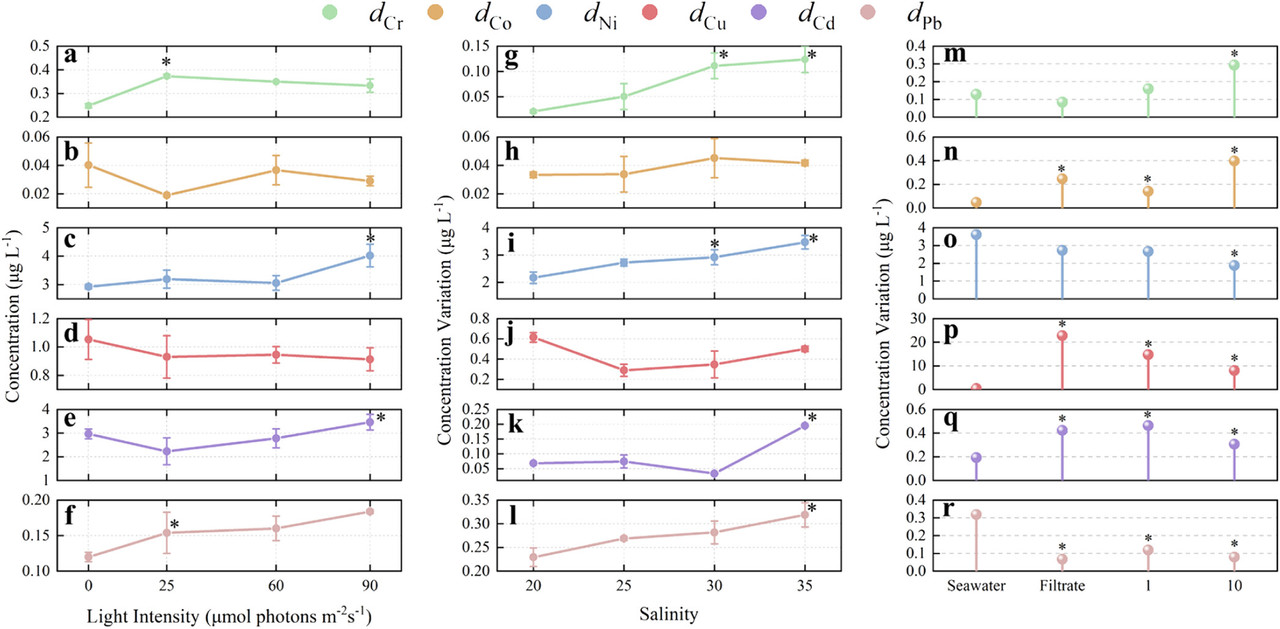
The caption:
Figure 3. Impact of environmental factors on heavy metal release. (a–f) Dissolved heavy metal concentrations under different light intensities. * indicates a significant difference from the dark condition (p < 0.05). (g–i) Dissolved heavy metal concentrations at varying salinities. “Concentration variation” refers to the difference between the postexposure concentration and the initial seawater concentration (salinities 20–35). * indicates a significant difference from a salinity of 20 (p < 0.05). (m–r) Dissolved heavy metal concentrations in seawater and Synechococcus sp. filtrate. “1” and “10” indicate the dilution factors (1× and 10×, respectively) of the leachate used in the experiments. “Concentration variation” refers to the difference between the postexposure concentration and the initial concentration of the leachate (or diluted leachate). * indicates a significant difference from seawater (p < 0.05).
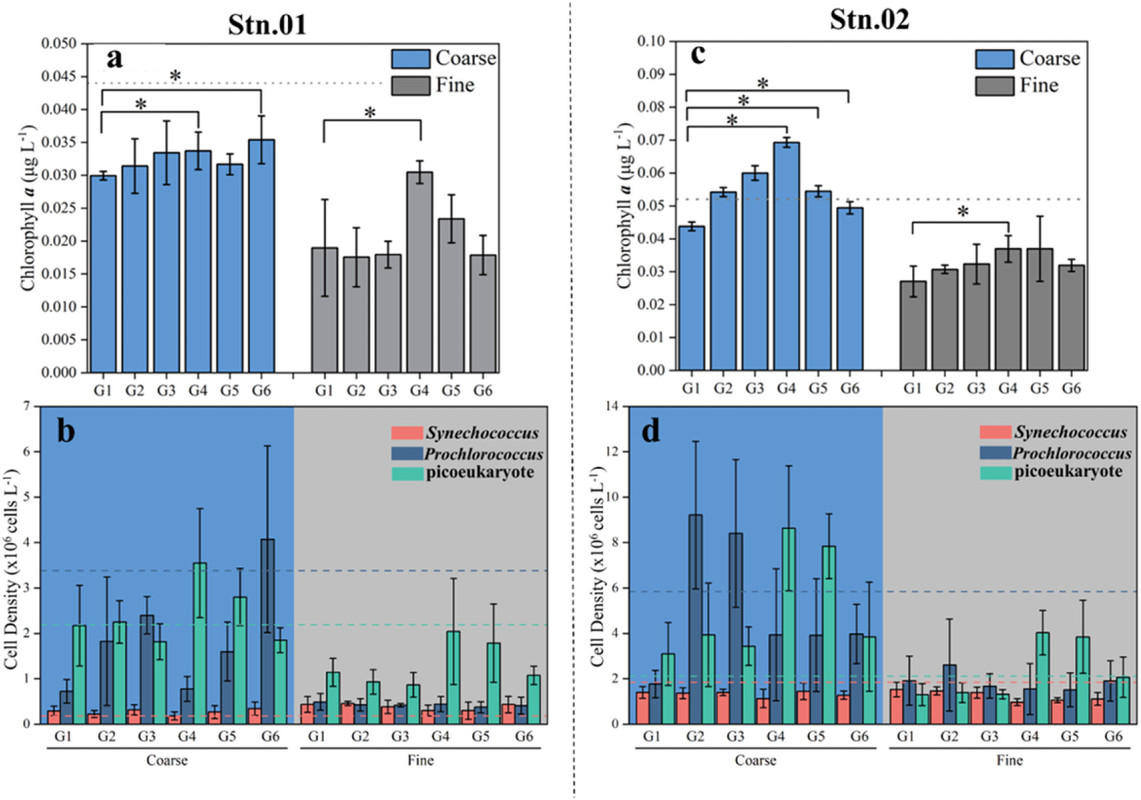
The caption:
Figure 4. Chlorophyll-a concentration in different treatment groups at Stn.01 (a) and Stn.02 (c) (the dashed line represents the chlorophyll-a concentration of the control). Cell density of Synechococcus, Prochlorococcus, and picoeukaryotes in different treatment groups at Stn.01 (b) and Stn.02 (d) (each colored dashed line represents the abundance of the corresponding picophytoplankton in the control). * indicates a significant difference between the two groups (p < 0.05).
The authors note that shading from the ore dust on Prochlorococcus
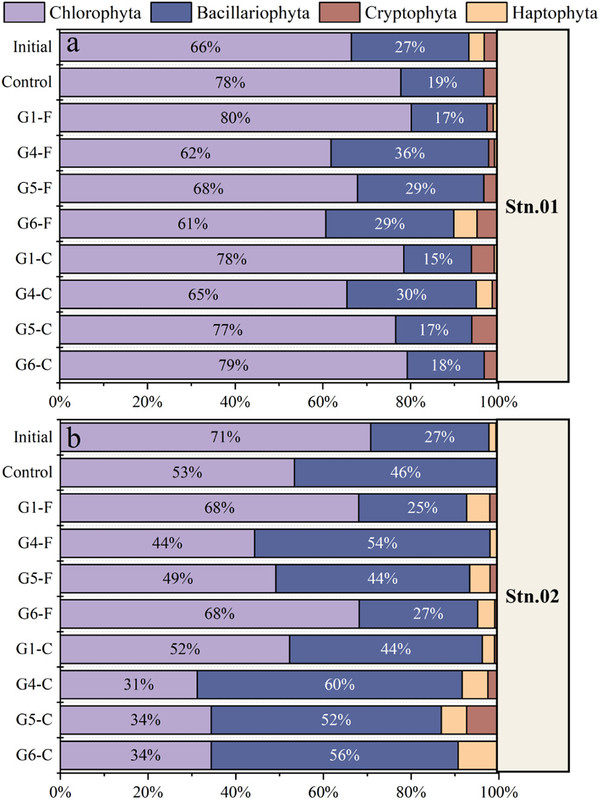
The caption:
Figure 5. Relative percentages of picoeukaryotes in different treatment groups at Stn.01 (a) and Stn.02 (b).
The groups of organisms in this graphic are Chlorophyta, Haptophyta, Cryptophytes, and Bacillariophyta.
The effects on growth of organisms, or suppression of growth was observed to be, unsurprisingly, connected with particle size, with finer particles being responsible for higher concentrations of metals in the water.
Let's return to Benny Sovacool, hand waver supreme, who for some reason - I'd call the reason "ignorance" but that's just my opinion - dismisses the fact that the highest energy to mass ratio is found in the fissionable actinides, with energy densities for full fission being on the order of 80 trillion Joules/kg. This means that if world energy demand is roughly 650 Exajoules per year, close to current figures which might be stabilized by process intensification using nuclear heat, that world energy demand might involve the complete fission of 8 thousand tons per year using for part of the cycle, a fast neutron spectrum. Although the devices in which this may be accomplished will require materials, because of the energy density, these will be relatively small. The Diablo Canyon nuclear plant, in two relatively small buildings easily and regularly produce more energy than all the wind turbines in California.
Nevertheless Benny has a happy face on mining the seabed for metals, because he has faith that it will be, um, regulated. As we all know, mining companies are scrupulous on being "green," just as Benny is sure he is green.
Quoth Benny:
Although primary emphasis must be placed on resource efficiency (higher output or usage of product per unit of resource input) and recycling, there will likely be a need for primary resource extraction as well owing to clean-energy infrastructure demand. New resource streams—including metal availability in seawater (desalination) and groundwater (geothermal brines), material substitution or material intensity reductions, and materials recovery and recycling—also hold promise for diversifying supply chains, as long as they maintain environmental sustainability and protect worker safety.
Although mining in terrestrial areas is likely to continue to meet the demands of low-carbon technologies in the nearer term, we need to carefully consider mineral sources beneath the oceans in the longer term. The International Seabed Authority, set up under the United Nations (UN) Convention on the Law of the Sea, is in the process of issuing regulations related to oceanic mineral extraction. This process is a rare opportunity to be proactive in setting forth science-based environmental safeguards for mineral extraction. For metals such as cobalt and nickel, ocean minerals hold important prospects on the continental shelf within states' exclusive economic zones as well as the outer continental shelf regions. Within international waters, metallic nodules found in the vast Clarion-Clipperton Zone of the Pacific as well as in cobalt and tellurium crusts, which are found in seamounts worldwide, provide some of the richest deposits of metals for green technologies. Difficult extraction and declining reserves of some terrestrial minerals, as well as social resistance against terrestrial mining, may lead to oceanic mineral reserves becoming more plausible sources...
Although mining in terrestrial areas is likely to continue to meet the demands of low-carbon technologies in the nearer term, we need to carefully consider mineral sources beneath the oceans in the longer term. The International Seabed Authority, set up under the United Nations (UN) Convention on the Law of the Sea, is in the process of issuing regulations related to oceanic mineral extraction. This process is a rare opportunity to be proactive in setting forth science-based environmental safeguards for mineral extraction. For metals such as cobalt and nickel, ocean minerals hold important prospects on the continental shelf within states' exclusive economic zones as well as the outer continental shelf regions. Within international waters, metallic nodules found in the vast Clarion-Clipperton Zone of the Pacific as well as in cobalt and tellurium crusts, which are found in seamounts worldwide, provide some of the richest deposits of metals for green technologies. Difficult extraction and declining reserves of some terrestrial minerals, as well as social resistance against terrestrial mining, may lead to oceanic mineral reserves becoming more plausible sources...
There you have it: To be "green" hand waving Benny says, well, shit, we can always tear up the ocean floor, filling the water with wet mining dust to leach cadmium, lead and chromium.
Don't worry, be happy:
The authors of the paper currently discussed in their conclusion, note that the addition of iron may actually enhance the growth of some organisms, even if the copper, cadmium, chromium and lead might be bad for them and the stirring of all that silicon dioxide in the tailings to be dumped so we can mine the fuck out of the planet to be "green" will help silicon deficient waters be amenable for diatoms.
We're saved.
Of course, all of Benny's remarks, as well as the remarks in the paper referenced here, should, with just a little honest reflection call into question whether so called "renewable energy" is actually "renewable." What happens when we've run out of ocean floor to tear up, assuming that we can get that far without destroying the plankton on which the bulk of the world's oxygen supply depends?
I'm sure too, that somewhere in his pixilated mentality and the mentality of his legions of fellow antinukes, there's some magical answer to all of this, although up until now, all that this endless bullshit about what is and what is not "renewable" and "sustainable" has done nothing, zero, zilch, to arrest the ongoing acceleration of the dangerous fossil fuel waste carbon dioxide in the atmosphere. I'm quite sure too, that Benny and his coreligionists are sure that they can fuel all those barges, mining equipment, transport equipment, refining, and reduction of ores to the metallic state with magical solar and wind and even more of the trillions of dollars thrown at this exercise in wishful thinking. Afterall, antinukism is working out great, isn't it? I mean, what's a few million acres of forests burning each year, deaths from extreme heat, collapsing agriculture systems, and extreme weather between friends. We'll get "there," whatever "there" means to these airheads.
By the way, endless mining of the seafloor is not "sustainable" as Benny would have it, despite placing this abused word in his title. Nor does so called "renewable energy" have anything at all with addressing climate change. We have already sunk on this planet trillions upon trillions of dollars on this antinuke affectation with the result, with respect to the accumulation of fossil fuel waste in the planetary atmosphere, is accelerating, not decelerating. The opening words of his text "Climate change mitigation..." are also inherently dishonest. The purpose of the wind and solar fantasy was never about fighting "climate change," now better described as "extreme global heating," which is here now. The purpose of the fantasy was about attacking the only sustainable, clean, and available indefinitely form of energy, nuclear energy.
It is now too late for nuclear energy to save what might have been saved, or restore what might have been restored, but nuclear energy remains, whatever remains possible for it, the best option before humanity. This is the price paid by the literally pyrrhic "victory" of the antinukes of Sovacool's ilk. Rather than make things even worse by chasing a chimera on the seafloor, we should be building nuclear reactors as fast as is possible, learning along the way, how to make the manufacturing and fueling infrastructure as robust as it once was, here, where we once built more than 100 in 25 years while providing the lowest cost electricity in the industrial world and is, now, in China, where 58 reactors have been built in this century, with 33 more under construction.
Have a swell day.